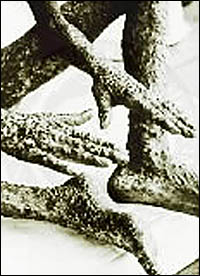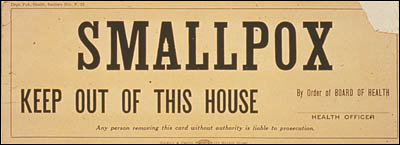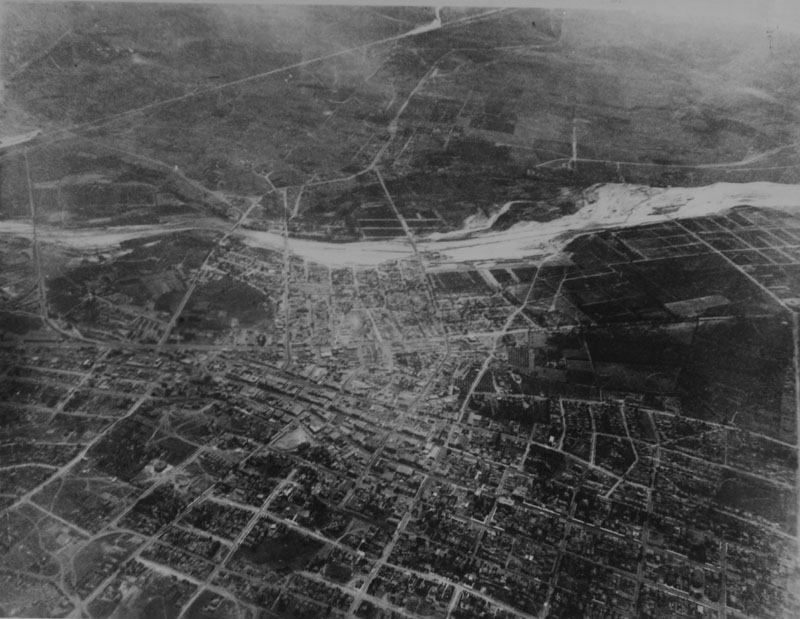Outbreak, alarm and yellow flags
In the early months of 1887 smallpox made a deadly resurgence into California. According to the State Board of Health, this disease first appeared in the city of Los Angeles on February 16 after having been imported from Mexico. It ultimately caused fifteen deaths (from about 120 cases) in the city through June of this same year. An estimated 10,000 people fled Los Angeles to avoid contagion. From early 1887 to the end of the fiscal year on June 30, 1888, smallpox caused ninety-four deaths throughout the State.
 |
| Unknown victim of severe smallpox (not from the 1887 L.A. epidemic), NLM |
Smallpox is a highly contagious and often fatal disease characterized by fever, rashes, pustules and scabs. The World Health Organization states that smallpox is "one of the most devastating diseases known to humanity...decimating populations and changing the course of history." Vaccination is the only prevention.
Smallpox outbreaks have occurred for thousands of years, but the disease is now eradicated. The last case in the United States occurred in in 1949, and the last natural case in the world occurred in Somalia in 1977.
An earlier outbreak of smallpox in the City of Angels occurred during the Civil War years. The Los Angeles Star reported in November 1862 that the town's native American population had suffered seven cases of smallpox wth two deaths. In February of the next year, the local Board of Health was aware of 319 cases of the disease.
During the 1887 outbreak, houses in Los Angeles containing smallpox were ordered to be marked with yellow flags. Twenty thousand circulars about smallpox were distributed throughout California that included the following:
"After an absence of many years, smallpox has again been imported into our State...The State Board of Health feels its imperative duty to present certain suggestions and precautions...No time should be lost, but a general vaccination insisted upon...it is our great privilege to live in California, the inhabitants of which are too intelligent and well informed not to see the importance of this measure when smallpox invades their town.."
Fortunately the form of smallpox that struck Los Angeles, while prevalent, was of the mildest character. But as the State Board of Health noted at the time, if the type of this disease had not been "devoid of any epidemic tendency, the spread of this disease would have been unlimited, and the death rate consequently increased."
 |
| Quarantine poster used in CA. in the early 20th century |
The Los Angeles area at the beginning of 1887 was doing quite well. Real estate was booming. Two transcontinental and four local railroads were running. Streets were being paved with asphalt. Businesses were opening, many schools were being built, and thousands of people from the East and elsewhere were flocking to the growing and well-sanitized city for health and pleasure. Over 45,000 people lived in the city of L.A. at this time.
 |
| Aerial photo of Los Angeles in 1887 |
Los Angeles Mayor William H. Workman in March 1887 diplomatically stated that: "Rumors of the State Board of Health, having in view the quarantining of this city, are entirely erroneous...There is no cause for alarm from smallpox in this city...The authorities are taking the most effective measures to eradicate the smallpox from our midst."
The State Board of Health, however, while acknowledging that the smallpox situation was not as dire as portrayed, nevertheless was upset with what it saw as "extreme secrecy" and lack of urgency and recogntion of potential danger from the Los Angeles press and residents.
The board complained that their "worthy efforts were belittled...Instead of cooperating and doing all in their power to throttle the disease in its first visitations, these would-be sanitarians scoffed and sneered...The result of this was to make people comparatively careless." They lamented that the local media attacked their board members in the "most shameful manner" and impugned their motives.
The "Great indignity," "vicious stab" and "infection" of L.A.;
San Pedro quarantined
As hostile as it was to the State Board of Health, however, the Los Angeles press was even more bellicose towards the city's northern rival San Francisco, whose local Board of Health (that included San Francisco mayor Edward B. Pond) adopted this resolution in March of 1887:
"Resolved, that the city of Los Angeles be declared infected with smallpox, and as the port of San Pedro is the port of departure from that city, it be declared infected, and that all vessels arriving therefrom shall be placed in quarantine until thoroughly inspected by the quarantine officer.
The Los Angeles Times was outraged, criticizing San Francisco's "narrow-minded capitalists" and stock jobbers" that have "been ever ready to stamp this southern city into the dust." The Times particularly criticized San Franciso's health board for its "vicious stab," "asininity" and "spite-work" for quarantining San Pedro which was as "unnecessary as vacinating the moon." When the health board refused to lift the quarantine in early April, the Times sarcastically declared the board "refuses to redeem itself by an intermittent spark of intellect."
Lessons learned
The State Board of Health learned two important lessons from the epidemic of smallpox in 1887: 1) while isolation and quarantine were critical, they were not were not sufficient in stopping the disease, and 2) vaccinations (as often performed at the time) offered no protection. (In Los Angeles, of the 30,000 vaccinations given during this period, at least one-third had to be given again.) Thorough vaccination and revaccination were an "almost absolute preventative."
Sources:
Centers for Disease Control and Prevention. Smallpox Fact Sheet, Smallpox Disease Overview.
Tenth Biennial Report of the State Board of Health of California. For the Fiscal Years from June 30, 1886, to June 30, 1888. Sacramento: State Office: J.D. Young, Supt. State Printing. 1888.
Los Angeles Star. November 1862, February 1863.
Los Angeles Times. January, February, March, April 1887.
World Health Organization. Smallpox.

